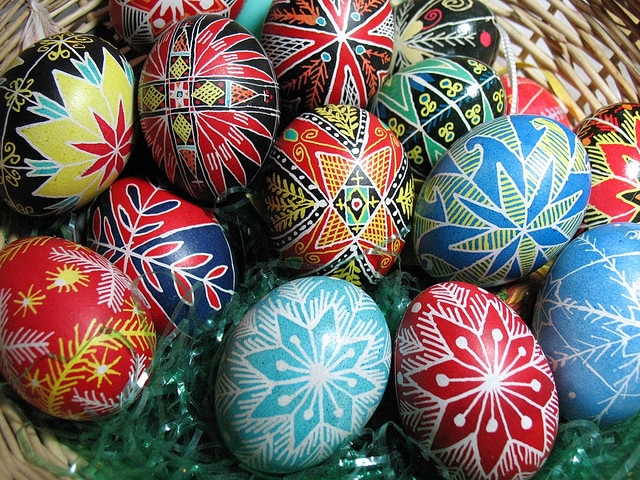
There are many festive cultural traditions in Ukraine. Easter is particularly interesting, with many rituals taking place for over a week around the holiday. It begins with the seven holy days of Lent. During this time meat and an additional individually selected item or self-indulging practice is given up. Following this, festivities and pysanky (Ukrainian Easter egg) decorating begins.
Probably the most famously recognized aspect of Ukrainian Easter, colorful pysanky are the crowning jewel of the season and are given as presents to represent the gift of life. Eggs are designed using a beeswax stylus to make a dye-resistant coating. To create colorful designs, eggs are dyed several times, with additional designs being added with each additional layer of color. Once the design has been completed, the wax is melted off using a candle and the full creation is finally revealed.
The excitement of the returning spring season eventually inspired many ornate design patterns, turning pysanky creating into a true art. Friends and families come together every year to huddle together over their eggs, laughing and gossiping about whom the new egg da Vinci is and whose designs wouldn’t pass through egg-making kindergarten.
The now completed pysanky are then placed in a wicker Easter basket along with Easter breads such as paska and babka, ham, sausage, horseradish, cheese and butter. These baskets are then taken to church to be blessed on Saturday and then eaten after service on Sunday.
The baskets not only have religious significance, they also give family chefs a much-needed break from the kitchen, as they are prepared days in advance.
For kids (and kids at heart), when it comes time to eat the contents of the basket the hard boiled eggs take center stage. Everyone is given the chance to choose an egg for the traditional egg-smashing contest. Here, opponents and their eggs are pitted against each other in one-on-one “battles” where eggs are smashed against each other until the surface of one is cracked, revealing a loser. Rounds continue until a sole egg remains. Competition can get quite heated. Strategies can vary greatly, from smashing an opponent full on in hopes of cracking your own egg and getting to be the first person to eat, to false starts and exact hit angles to come out as a winner.
Pysanky. Top photo courtesy of couleewinds.
Contributed by guest author, Judi Zienchuk.

Jessica Festa is the editor of the travel sites Jessie on a Journey (http://jessieonajourney.com) and Epicure & Culture (http://epicureandculture.com). Along with blogging at We Blog The World, her byline has appeared in publications like Huffington Post, Gadling, Fodor’s, Travel + Escape, Matador, Viator, The Culture-Ist and many others. After getting her BA/MA in Communication from the State University of New York at Albany, she realized she wasn’t really to stop backpacking and made travel her full time job. Some of her most memorable experiences include studying abroad in Sydney, teaching English in Thailand, doing orphanage work in Ghana, hiking her way through South America and traveling solo through Europe. She has a passion for backpacking, adventure, hiking, wine and getting off the beaten path.








